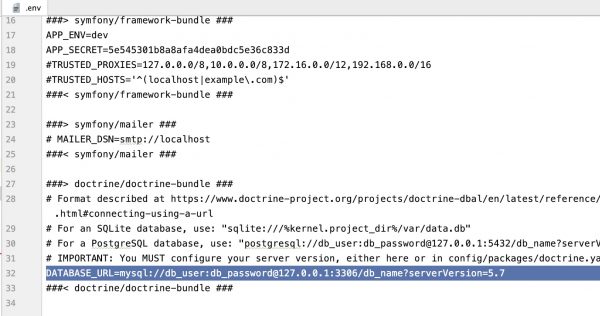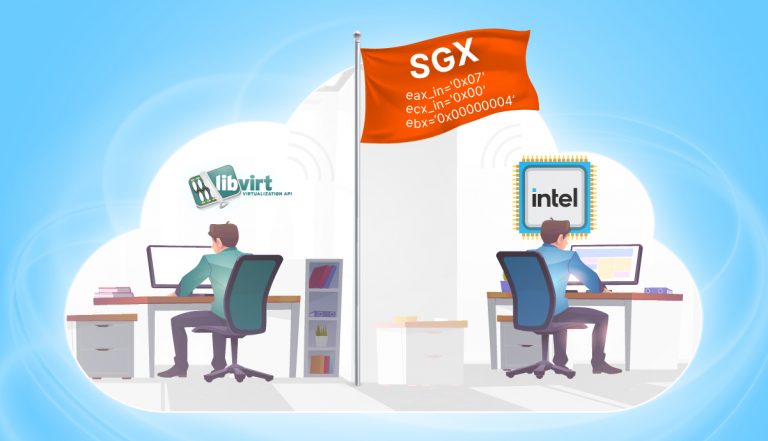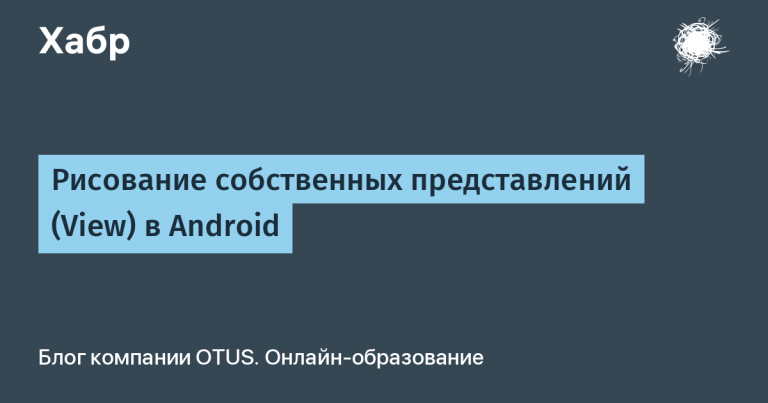Programming Quantum Computers: A Gentleman’s Kit by Peter Publishing House

We try very hard to track trends at the stage of their formation and prepare the most relevant books for Russian-speaking readers. Today I will show you how this happens. For example, I’ll take a rather unusual topic – programming quantum computers…
This story began 4 years ago, and now, at the end of 2020, we have already formed a small, but very affordable and up-to-date portfolio…
In 2016, a very entertaining book came to our publishing house from foreign colleagues: The Future X Network: A Bell Labs Perspective… If you haven’t heard about Bell Labs before, be sure to take an interest. A very outstanding organization!
Unfortunately, it was never published in Russian. Yet we studied it carefully. This is not abstract futurology, but a very serious study with predictions up to 2025, which are foolish to ignore. Moreover, checking now, 5 years after these forecasts were drawn up (the book was written in 2015, even before Nokia bought them), their validity is very impressive.
Among the many topics, our attention was particularly drawn to those related to computing. Supply and demand, technologies and prospects. It was here that we received the first serious signals that cloud computing and infrastructure, quantum computers are turning from assumptions and experiments into a tangible, accelerating factor in the transformation of all IT (and a little later, not IT too).
With these thoughts and feelings, we began to search.
Everything about clouds, machine learning and big dates is quite understandable, you are familiar with our books on this topic. Therefore, we were looking for confirmation of demand (at this time, the Hub of quantum technologies was actively growing). We were looking for authors and books that will be useful to readers at the current stage of development of quantum technologies and in the near future.
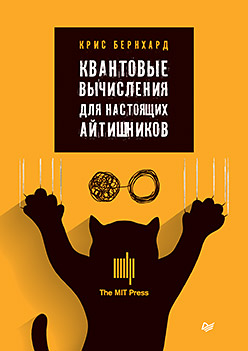
Finally, towards the end of 2018, desires converged with opportunities. We found and accepted into the publishing plan our first book from this portfolio: “Quantum Computing for Real IT People”.
Almost a year has passed from making a decision to putting the book on the shelves of retail and virtual stores.
Since it was difficult with practice at that time, because there were still no working machines with an adequate size of quantum volume, we reasoned that an understandable and accurate guide to the theory of quantum computing would be more useful to our audience. The book strikes a delicate balance between the number of questions that need to be discussed with the reader, and the depth of the “jungle” that will have to get into so that the result is not deceptively simplistic.
Our morning star was The MIT press, which went on to become a bestseller on Amazon. By the way, we accepted the book for publication almost six months before its release in the West.
Then the unexpected happened!
The First Commercial Quantum Computer – IBM was presented at CES 2019. That is, we, of course, assumed that IBM would actively work in this direction. However, their success exceeded our expectations.
But more importantly, we received a signal that we should take up books not only on theory, but also on the practice of programming quantum computers. And without waiting peritonitis publication of the first book, it was decided to move from probing the topic directly to the formation of a line of literature.
After going through all the options, a few months later, we chose a book from Vladimir Silva, an active researcher and developer working in various divisions of IBM related to promising technologies and large-scale computing.
It was clear to us that IBM was becoming the leader in the quantum race. They have the experience, resources, customers and determination to transform the latest technology into an industry. Well, I also managed to get interesting and convincing information about the nearest plans / achievements from their scientific publications and booklets-guides for business. From everything it followed that at least in the next decade, it was their technology stack that would be the standard for “production”. Of course, within the limits in which we can talk about the production of such a young technology.

“Development with Quantum Computers” is suitable for developers who already have at least basic knowledge of CS and the basics of the Python language. The book is intended to develop skills in working with both a simulator and a real quantum computer, to which IBM provides free of charge access. The author teaches us to use a special framework from IBM (we write code in Python, the framework itself translates it into commands for hardware and optimizes them), and also offers the minimum required set of theory. There are also several small educational projects that clearly implement a special approach to solving problems, taking advantage of the benefits of quantum computing. In general, ideal for those who like to play first, twist and only then decide how much time to spend on in-depth study.
We managed to release this book on time, in the same month CES 2020, IBM and the first real commercial application of the new quantum computer took place. Passed and fully confirmed all the assumptions and statements that we were guided by.
I found a scientific editor for this publication on Habré (Mikhail Korobko aka Shkaff). Surely many of you have read his fascinating posts on gravitational astronomy and quantum technologies, thanks to which it (astronomy) became possible.
By the way, the circulation of the book is almost sold out. If she is interested, I strongly advise you not to postpone the purchase, otherwise you will have to be content with the electronic option.
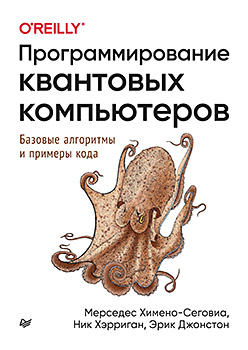
The third book in our portfolio is “Programming Quantum Computers. Basic Algorithms and Code Examples”.
As the name implies, this is a cross between the previous two. On the one hand, we are learning something pretty fundamental – algorithms. Although much more dynamic than the very foundations of quantum physics and quantum computing, which were discussed in “Quantum Computing for Real IT People.” Practical problems for quantum computers are just beginning to be posed, and the ensemble of algorithms will continue to grow for a long time. That does not prevent you from starting to study the already created ones, and perhaps making your own contribution and suggesting the algorithm to the community.
On the other hand, we are very carefully looking at how to implement them using current frameworks and hardware. That is, the applied character of the present tense is evident. Especially in a situation where most developers, in principle, have little understanding of how and why quantum computing will be implemented, how applicable their current algorithmic favorites are.
The author chose Microsoft as the main infrastructure – the second, in our opinion, player in this race. Public tools, the same Q #, they began to develop earlier than IBM, it is even seen in specialized Russian master training programs. Thus, this decision to use Microsoft’s developments is not ideological, but quite pragmatic. However, this is not a high-tech game book. For example, this is how the author combines quantum physics, hardware, software and programming theory:
If you want to master teleportation, it’s best to give it a try. Keep in mind that throughout human history up to the time of this writing, only a few thousand people performed physical teleportation of some kind, so even running the following code puts you among the pioneers. For this example, instead of a simulation system, we will use a real five-qubit QPU from IBM (Figure 4.1). You can copy the sample code in Listing 4.1 to the IBM Q Experience site, click the button, and verify that the teleportation was successful.
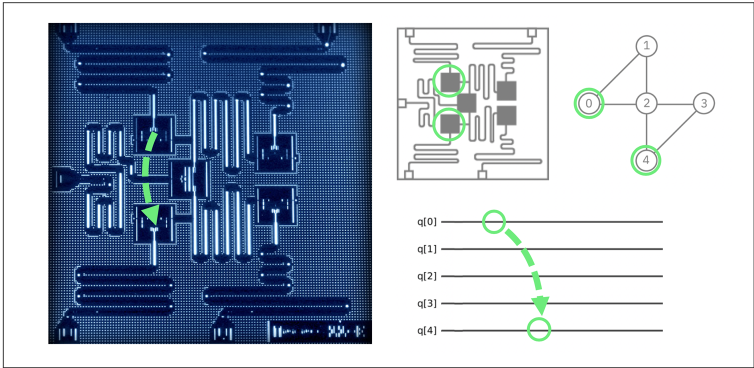
You can use OpenQASM and Qiskit to program IBM Q Experience. Note that Listing 4.1 does not contain JavaScript for execution in QCEngine, but OpenQASM for execution in the IBM cloud frontend (Figure 4.2). Running this code will allow you to actually teleport a qubit at the IBM Research Center in Yorktown Heights, New York, rather than simulate it. We will describe in detail how this is done. Taking a closer look at this code will also help you understand exactly how quantum teleportation works.
Sample code
This example can be done online at http: //oreilly-qc.github. io? p = 4-1.
Listing 4.1. Teleport with check
include "qelib1.inc";
qreg q[5];
creg c[5];
// Шаг 1: создать запутанную пару
h q[2];
cx q[2],q[4];
barrier q[0],q[1],q[2],q[3],q[4];
// Шаг 2: подготовить данные
x q[0];
h q[0];
t q[0];
barrier q[0],q[1],q[2],q[3],q[4];
// Шаг 3: отправить
h q[0]; h q[2];
cx q[2],q[0];
h q[2];
measure q[0] -> c[0];
measure q[2] -> c[2];
barrier q[3],q[4];
// Шаг 4: получить
x q[4];
z q[4];
barrier q[3],q[4];
// Шаг 5: проверить
tdg q[4];
h q[4];
x q[4];
measure q[4] -> c[4];The scientific editor of the book was already known to you Mikhail Korobko aka Shkaff

And now a short announcement of the fourth book still in production – “Dance with Qubits. How Quantum Computing Really Works”.
Posted by Robert Sator (hi TENET, hi Nolan!), IBM vice president of quantum computing.
Author CV
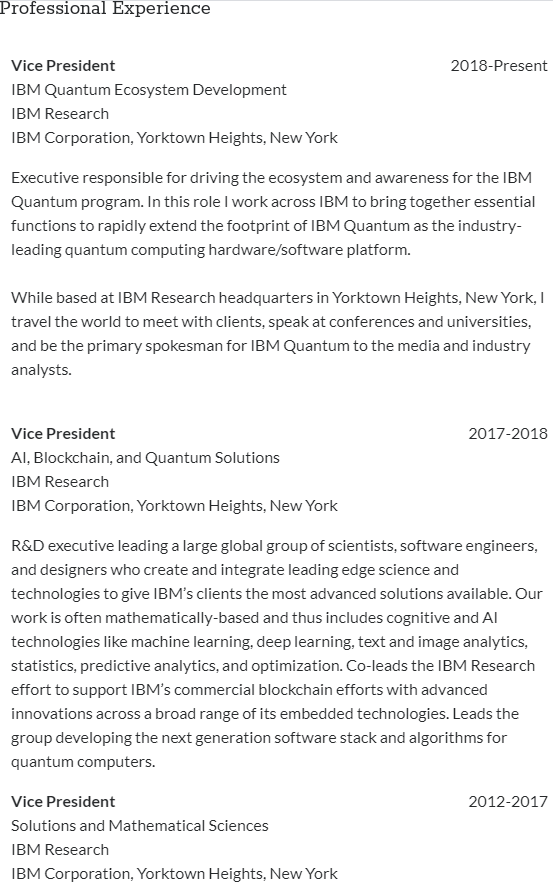
This will be our fourth edition on quantum computing and programming of quantum computers. Extensive and detailed, more like the classic computer literature you are used to. There is, of course, quite a bit of math inside, but that doesn’t scare you in good books on Machine Learning and Deep Learning?
Colleagues in Risky Business singled out the book as the most important for anyone looking to get serious about quantum computing.
“A very necessary and long-awaited addition to the body of literature on quantum computing. Fresh, provocative and deeply thought-out, with sections on basic math tools available to everyone. Highly recommend!”
Ilyas Khan, CEO, Cambridge Quantum Computing
You can read more about the book in our blog during the pre-order / start of sales. Unfortunately, I cannot name the exact date now, I will orient it to the beginning of 2021. I advise you to subscribe to our blog and / or mailing list so as not to miss!
By the way, since we are talking about uncertainties throughout this post, I advise you to pay attention to our book “Probabilistic Programming in Python: Bayesian Inference and Algorithms”. There were no quantum effects here, but it’s also very interesting and everything is clear.
Let’s summarize… This is how we at Peter Publishing House are working to provide our readers with access to the cream of computer literature. Of course, you won’t be able to get rid of some lag with the English-speaking world. However, we work proactively, we often look at books at the concept stage from Western publishers and instead of you we sort hundreds of books, catching the best! I can confidently say that among the local (national) book markets, the Russian-speaking reader from IT gets the widest and most relevant choice.

